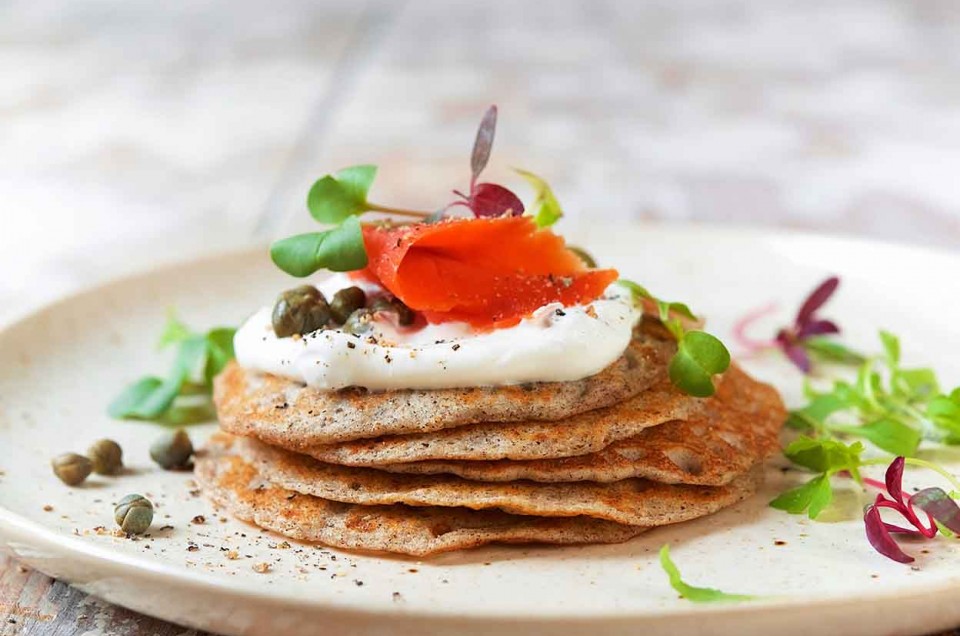Blini: Exploring the Culinary Heritage and Timeless Delight of Russian Pancakes

Introduction: Blini, delicate and golden Russian pancakes, are a beloved staple of Russian cuisine, cherished for their fluffy texture, subtle sweetness, and endless versatility. Originating from the vast landscapes and rich culinary traditions of Russia, Blini have been enjoyed for centuries as a symbol of warmth, hospitality, and celebration. In this comprehensive exploration, we’ll delve into the origins, cultural significance, and enduring appeal of Blini, as well as provide a step-by-step guide to preparing this beloved dish in your own kitchen.
Origins and Cultural Significance: The origins of Blini can be traced back to ancient Russia, where they were traditionally made from buckwheat flour and cooked on a flat griddle or skillet. Originally a symbol of the sun, Blini were traditionally prepared during pagan festivals celebrating the arrival of spring and the rebirth of nature. Over time, Blini became associated with religious holidays, particularly Maslenitsa, a Russian festival marking the end of winter and the beginning of Lent.
Blini hold a special place in Russian culinary culture, serving as a versatile canvas for a wide variety of sweet and savory toppings. They are often enjoyed as a festive treat during Maslenitsa celebrations, served with an array of toppings such as sour cream, caviar, smoked salmon, jam, or honey. Blini are also a popular street food in Russia, sold by vendors in bustling markets and city squares, where they are enjoyed by people of all ages.
Recipe: Now, let’s explore the step-by-step process of making Blini from scratch. While there are countless variations of Blini recipes, we’ll focus on a classic recipe using all-purpose flour, which produces light and airy pancakes with a delicate flavor.
Ingredients:
- 1 cup all-purpose flour
- 1 cup milk
- 1 egg
- 1 tablespoon sugar (optional)
- 1/2 teaspoon baking powder
- Pinch of salt
- Butter or oil for cooking
Instructions:
- In a large mixing bowl, whisk together the flour, sugar (if using), baking powder, and salt until well combined.
- In a separate bowl, beat the egg lightly, then add the milk and whisk until smooth.
- Gradually pour the wet ingredients into the dry ingredients, stirring gently until a smooth batter forms. Be careful not to overmix, as this can result in tough pancakes.
- Let the batter rest for 10-15 minutes to allow the flour to hydrate and the baking powder to activate.
- Heat a non-stick skillet or griddle over medium heat and add a small amount of butter or oil to coat the surface.
- Pour a small ladleful of batter onto the skillet, using the back of the ladle to spread it into a thin, even circle.
- Cook the Blini for 1-2 minutes on each side, or until golden brown and cooked through.
- Transfer the cooked Blini to a plate and cover with a clean kitchen towel to keep warm while you cook the remaining pancakes.
- Serve the Blini hot, topped with your choice of sweet or savory toppings.
Background and Variations: Blini have evolved over the years, with different regions and families putting their own unique spin on the classic recipe. While the traditional recipe calls for all-purpose flour, other variations may use buckwheat flour, cornmeal, or whole wheat flour for added flavor and texture. Additionally, some recipes may include flavorings such as vanilla extract, lemon zest, or cinnamon for a hint of warmth and complexity.
Conclusion: In conclusion, Blini are more than just pancakes; they are a culinary tradition that celebrates the rich history, vibrant flavors, and enduring spirit of Russia. Whether enjoyed as a festive treat during holidays and celebrations or as a comforting meal on a cold winter’s day, Blini continue to captivate taste buds and bring people together around the table. So why not try your hand at making Blini at home and experience the timeless tradition and delightful taste of this beloved Russian dish for yourself?




